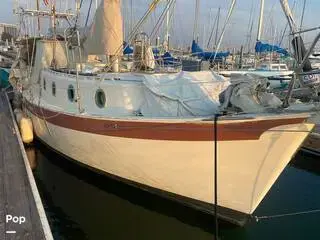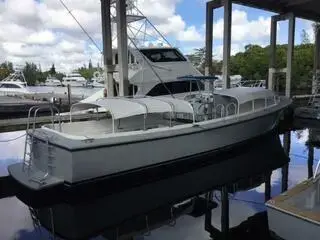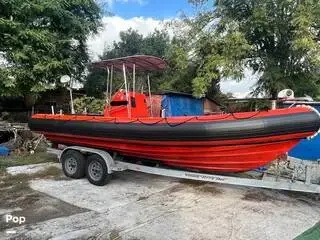
$24,500
LENGTH:
29.99 ft.
|
YEAR:
1978
LOCATION:
Emeryville, California
OFFERED BY:
POP Sells

LENGTH:
50.0 ft.
|
YEAR:
1979
LOCATION:
Fort Lauderdale, Florida
OFFERED BY:
Rick Obey Yacht Sales

LENGTH:
24.02 ft.
|
YEAR:
2003
LOCATION:
North Hills, California
OFFERED BY:
POP Sells
Boat not available.
LOCATION
San Carlos, Sonora, Mexico
YEAR
1978
LENGTH
39.76 ft.
Condition
Used
Name
Lilliana
Year
1978
Make & Model
Willard Marine 40 FBS
Boat type
Power
Length
39.76 ft.
Fuel Type
Diesel
Location
San Carlos, Sonora, Mexico
Beam
13.68 ft.
Cabins
2
Draft
4.27 ft.
This 1978 Willard 40, Lilliana, is a sea kindly, long range cruiser with an extremely reliable motor and mechanical systems. She was hull #20 if this design, built in California – in fact, she is the very boat used on the brochures of Willard Marine’s 40’ Trawler!
After 14 years of happily cruising Lilliana in Mexico and Alaska her owners have reluctantly decided to sell her.
This 1978 Willard 40, Lilliana, is a sea kindly, long range cruiser with an extremely reliable motor and mechanical systems. She was hull #20 if this design, built in California – in fact, she is the very boat used on the brochures of Willard Marine’s 40’ Trawler!
After 14 years of happily cruising Lilliana in Mexico and Alaska her owners have reluctantly decided to sell her. She has been lovingly cared for and is in perfect shape, mechanically and cosmetically. Lilliana is a sailor's trawler with beautiful lines, a sea kindly, stabilized ride, with a well-appointed interior.
She has a range of over 2400 miles and can safely take her crew anywhere on the planet. She was launched in 1978 and is berthed in the Sea of Cortez in San Carlos, Sonora (5 hours from Tucson, AZ).
One of the few truly turn-key boats available. This one is worth the trip over to be impressed by her amazing upkeep and maintenance.
Boarding from the starboard side gate, step in to the aft cockpit, with seating for up to 8 people around the stern transom. Center table at cockpit. To starboard is the ladder to the flying bridge area. Midships is the main salon entrance.
At the cockpit sole is access to the cavernous workshop area, where you have large amounts of storage, access to the watermaker and steering systems.
This sedan design makes movement within the one-level cabin very easy – there are no stairs between the spacious cockpit, saloon and galley, in contrast to pilothouse designs involving climbing up and down stairs to access the helm and sleeping quarters.
Sleeps six in two cabins and salon; U-Shaped galley with plentiful storage. In 2016 all the large, side and forward windows and frames were replaced by tempered 1/4" thick glass. Visibility is excellent.
All upholstery and carpets are in excellent condition.
Access to the clean engine room is at the center of the main salon sole.
Spacious flying bridge with commanding view. The flying bridge (often called boat deck) is a wonderful feature of this model Willard. There is spacious seating for five near the upper helm. From there the view is inspiring and the sound of the engine just a distant murmer. During the current owners 14 years of ownership, about 80% of the driving was done from the flying bridge. "Lilliana" really feels like a small ship from up there. Dozens of sailors who have visited "Lilliana" in Mexico have marveled at being on that bridge, looking down on the sea life and the sea itself.
Additional Exterior Features Include:
Main Salon:
Forward of the cockpit is the main salon where, at the aft port end, there is a fold-down dining table, just right for two people. There is also a removable dining table in front of the settee on the starboard side that can seat six. By having a removable table, the main cabin is opened up when dinner guests are not aboard. The salon’s settee is L-Shaped and very comfortable for lounging about or napping. The settee can be pulled out to form a double bed.
Galley:
The U-Shaped galley is at the forward port side. It includes a Princess stove/oven (2009), a deep sink and a very large custom built chest of drawers that holds most galley accessories. The laminate counters were renewed in 2009.
Adjacent to the galley on the starboard side there is a top loading, well insulated refrigerator-freezer. These are under the helm seat and can be accessed underway because the seat cushion is divided to permit opening either the freezer or refrigerator by the helmsperson shifting their position. There is also a (never used) “backup” 12v Engel freezer stored elsewhere.
Master Stateroom:
The captain’s cabin is forward of the galley on the port side. It includes an athwartship double bed with the pillow positioned amidships on the center line to minimize motion at sea. There is a great deal of storage in this room, in cabinets, closets, drawers and under the bed. There is also a sink in an alcove.
The head includes a Raritan Elegance electric toilet (installed in 2020) and an enclosed shower. Also a large counter and sink with more storage.
Guest Stateroom:
There is a very large V-Berth in the forward cabin. This cabin also has a great deal of storage space. Emergency exit from this cabin can be made through a ceiling hatch.
Access to the forward chain locker is at the forepeak of this cabin.
Deck:
Side decks on both sides leading forward. Unique drop down stairway from flying bridge to front deck.
Electronics and Helm:
"Lilliana" has most standard electronics (depth sounders x2- Furuno and Garmin), AIS (vesper transmit / receive and a second AIS receive only) ,VHF ( Standard-Horizon with remote mic), Furuno wifi radar (new 2020), Garmin chartplotter (with charts for Mexico and the Pacific Northwest).
For long range communications there is an Icom 718 all band transceiver, Icom antenna tuner and Pactor 3 modem. The system is used for marine SSB or Ham radio providing email, weather, and communication with other mariners and coast guard.
The present owner has avoided the single-point-of-failure nature of multi-function displays. For navigation and other functions the owners use a pair of ipads with software navigation programs (I-sailor, iNavx and Navionix) and radar screen viewing. These ipads are not included with the boat but replacements can be purchased on ebay for about $100-200 each, or a laptop will suffice.
There is an onboard stereo system that can play audio from any device that has a standard stereo connection (iphones, etc.).
Electrical:
"Lilliana" has a large (~1000Ahr) house battery bank consisting of 8 six volt Trojan batteries. Due to the energy efficiency of the vessel (mainly refrigeration and lighting), these have never been discharged more than 10%. At this minimal discharge, according to the manufacturer, the batteries should be good for over 6000 discharge cycles. Thus far (April 2021) there are only 360 cycles. A recent capacity test indicated there was at least 95% of capacity remaining. The house bank is monitored with a Link 10 panel mounted display.
There is a second bank of two 12V group 31 sealed batteries that can be used to start the generator. New in April 2021. When being charged by the engine or solar panels the two battery banks are automatically tied together with a combiner.
There are two 135watt solar panels mounted over the bimini on the flying bridge. Under summer sun conditions these supply all the energy required to stay at anchor indefinitely.
There are three large-output alternators available (two on the generator and one on the main engine), all in excess of 100A. They are controlled by two Balmar smart regulators. Considering the energy efficiency of the vessel this is all overkill but the next owner might desire to add more energy consuming devices.
Engine Details and Mechanical Equipment:
The engine room is comfortably accessed through a large, air-spring assisted hatch, in the center of the saloon. With the hatch open one can step directly down into the engine room and comfortably access the engine and other systems.
"Lilliana’s" engine was installed in about 2000. It is a 6-cylinder Perkins/Sabre 135 hp diesel. The engine has 5,120 hours on it, burns no oil, has no leaks, emits no smoke and starts instantly. Due to good maintenance, it is almost like new and will likely run at least another 10k hours. Typically the vessel consumes between 1.5 to 1.7 gal/hr cruising between 6.5 and 7 knots (S/L ratio between 1.1 and 1.16). Top speed is 8.4 knots. A fuel consumption of 1.5 gal/hr is indicative of a power output ~27hp. A detailed engine log is onboard recording all maintenance performed during the past 14 years.
In addition to the main 600 gallon fuel tank, there is a 55 gallon day tank that provides fuel polishing and continuous clean fuel. The fuel filters (one before the day tank, another before the engine’s secondary) both have vacuum gauges to provide early warning of filter changes. In practice the vacuum gauges rarely move off zero. The engine draws its fuel from the day tank supply that is "polished" as the tank is filled.
The Borg-Warner velvet drive transmission was overhauled and inspected in 2016, replacing seals and installing a more modern and failsafe damper plate. This model transmission can handle power loads as high as 200 hp and is hardly challenged at the low power required to drive "Lilliana".
In addition to the standard engine alarms (oil pressure and temperature) there is also a thermal alarm switch directly on the saltwater elbow to alert the captain of possible overheating before the engine itself get too warm.
The ceiling of the engine room is covered with 2" thick soundown acoustic insulation.
"Lilliana" has a diesel-electric “get home” system. Her powerful Pisces generator (based on an Isuzu diesel) provides three phase, 208 volt AC that powers a 7.5 hp electric motor that can be belt coupled to the propeller shaft. A frequency controller on the electric motor permits variable speeds and direction. In flat conditions this gives about a 4 knot speed. Thus far the “get home” feature has never been needed.
Mechanical Equipment:
The propeller shaft’s cutlass bearing was replaced in 2019. The 28” Propeller was balanced and “tuned” in 2016.
"Lilliana's" rudder was reshaped in 2012 following a design provided by naval architect Dave Gerr. This so called fishtail/capped rudder gives improved slow speed maneuvering in close quarters eliminating the need for a bow thruster or articulating rudder.
There is a “Spurs” rope-cutter on the prop shaft.
The two-station steering system is a Wagner hydraulic installation.
A Raymarine autopilot has controls at the main helm and remotely on the flying bridge. The helm pump is a Comnav unit with a Benmar back-up unit already plumbed into the system . A steering pump failure can be bypassed in about five minutes.
The boat also is equipped with an emergency tiller in case of a complete hydraulic failure.
The boat is equipped with a diesel Wallis forced-air heater (installed in 2016 for the two seasons she was used in the Northwest). There is also an engine heated “Red-dot” type heater for use underway.
The watermaker is a 16 gallon/hour Aquamarine unit that is belt driven from the prop shaft or from the get-home system’s electric motor (currently not connected).
Stabilization:
The hull form of a very fuel efficient, full displacement vessel, by design, has soft chines which give a tendency to roll when waves are on the beam. "Lilliana’s" hull is stabilized in large beam seas with an effective paravane system. The system was modernized in 2009 to permit easy deployment and retrieval of the fins. In areas subject to heavy seas, when underway the paravane poles are normally out so that deployment of the fins amounts to simply dropping them into the water. The present owner developed a unique system to retrieve the fins that does not involve heavy lifting or electric motors. Retrieval of a fin and replacing it in its “holster” on the stern takes about 2 minutes.
In 2020 a pair of roll stabilizing fins (sometimes incorrectly called bilge keels) was added to the hull. These damp rolling both at anchor and underway. They did not change either the maneuverability of the vessel or its fuel consumption.
There is also a pair of “flopper stoppers” that can be deployed at anchor from the same paravane lines. These are rarely required in the Sea of Cortez and were never used in the Pacific Northwest.
For the two seasons when "Lilliana" cruised the Pacific Northwest and Alaska the paravanes were never used because those waters are relatively sheltered. In 2017 the present owners motored from the Pacific Northwest to San Carlos, Mexico. With the paravanes deployed "Lilliana" handled five days (non-stop) of high winds and large seas off the coast of Washington and Oregon with minimal rolling and no spilled beverages.
Structure:
Willard was, and still is, a builder of vessels for the military. As such they followed many military specifications even on their recreational vessels. Willards have thick hulls and thick fiberglass decks (plywood cored on the main deck and foam cored on the flying bridge). There are no Teak deck maintenance issues. The balsa core in a large area on "Lilliana's" flying bridge deck was replaced with more modern rigid foam in 2012.
"Lilliana" was professionally spray painted with Awlgrip LPU in 2008/2009. Her finish has been protected ever since with frequent application of Awlcare polish. She looks great!
The entire cap rail and some trim is finished bright. The present finish on the cap rails was put down in 2017 and, after stripping to bare wood, consists of two coats of penetrating epoxy, followed by multiple coats of Cetol Natural Teak and finished with a couple of coats of Cetol Gloss. During storage periods, canvas covers completely protect the cap rails so refinishing should not be needed for a very long time. One new coat of Cetol gloss every few years should suffice.
"Lilliana" has very complete canvas covers for all windows and the cockpit. There is also a see-through cockpit enclosure that could be used in colder climates.
"Lilliana" has no blisters. The builder stopped using blister prone resins the year before her launch.
Safety:
There are multiple bilge pumps and emergency dewatering devices on board. The engine room sump is automatically emptied after triggering an electronic switch. A mid-hull pump is similarly triggered. There are pump counters on both sump pumps to monitor activity. There are three separate high water alarms.
In case of emergency flooding there are:
There are several conventional fire extinguishers and a fire blanket located in the galley.
A propane sensor/alarm is located below the stove.
In case of an engine room (ER) fire, there is a Halon fire extinguisher that can be fired into the ER without opening the ER hatch. The ER in monitored by a closed circuit TV camera so that in case the ER smoke alarm is activated, the captain can see if smoke is present before triggering the Halon extinguisher.
An emergency drop-down swim ladder provides reboarding capability in case a single-hander falls overboard.
A life sling is available on the flying bridge to help bring a person in the water back to the boat. Near the boarding gate there is a block and tackle and winch system that can assist in lifting a weakend and waterlogged person aboard.
Other:
Because "Lilliana" was intended for long range world cruising there is a wide variety of spares and maintenance items on board. Including: spare propeller, spare paravane, spare starter motor, spare alternator, emergency tiller, spare raw water pump for main engine, a multitude of hose clamps, marine wire, zincs, filters, etc.
All manuals for "Lilliana’s" equipment are on board.
Engine and generator hours are as of the date of the original listing and are a representation of what the listing broker is told by the owner and/or actual reading of the engine hour meters. The broker cannot guarantee the true hours. It is the responsibility of the purchaser and/or his agent to verify engine hours, warranties implied or otherwise and major overhauls as well as all other representations noted on the listing brochure.
The company offers the details of this vessel in good faith but cannot guarantee or warrant the accuracy of this information nor warrant the condition of the vessel. A buyer should instruct his agents, or his surveyors, to investigate such details as the buyer desires validated. This vessel is offered subject to prior sale, price change or withdrawal without notice.
Cruising Speed
7
Engine Count
1
Engine Horse Power
135.00
Engine Hours
5150.00
Engine Location
Middle
Max Speed Knots
8.4
HULL
Hull Material
Fiberglass
OTHER
Country Built
United States
Displacement(kgs)
33000
Engine Type
Inboard
Fuel Capacity Gal
655
Fuel Tanks Capacity
2479.44
No of Heads
2
Holding Tank Gal
75
Holding Tanks Capacity
283.91
Water Capacity Gal
260
Water Tanks Capacity
984.21
The Willard Marine 40 FBS is 40 feet long that boasts a 14 feet beam and can hold up to 655 gallons of fuel and 260 gallons of water. This 1978 diesel Willard Marine 40 FBS powered by Perkins sabre with 135.00 horsepower is capable of reaching a maximum speed of 8.4 knots and a cruising speed of 7. The Willard Marine 40 FBS is made of fiberglass.